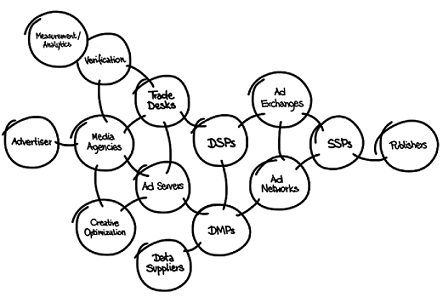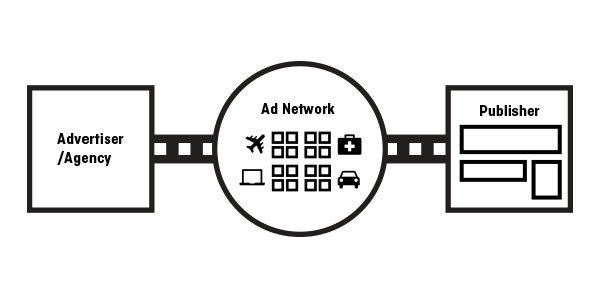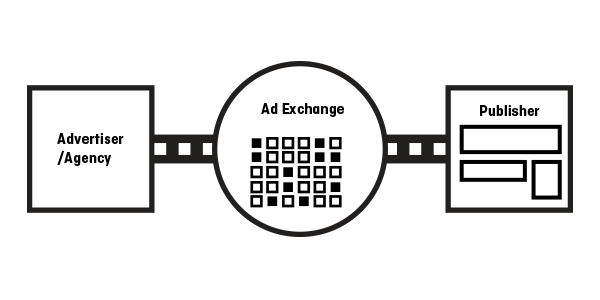The digital-advertising ecosystem has gotten quite complex, but if you have the distinct impression that it is getting too complicated to handle, just remember: it’s all about relationships.
Understanding and taking advantage of those relationships is key to success in today’s digital world.

Advertiser and Publisher: A Maturing Relationship
At its core, the digital-advertising ecosystem is built around one fundamental relationship — the one between advertisers and publishers.
Advertisers want to promote their goods or services, thus they need to buy ad space across various channels. Publishers are interested in making money by selling space on their website, blog, or mobile app to (almost) anyone who is interested. This relationship has existed for almost as long as people have been doing business.
As with most relationships, however, this one has matured with time. Publishers moved to the Internet, where the exploding number of webpages created a massive number of new places to put ads.
Opportunities for doing business and selling products and services online meant a lot more people trying to get out their message, leading to a growth in the number of advertisers as well.
So, much like in human relationships, this became complicated as both sides grew more separated by time and space — by space because a company in India may want to (and now can) target ads to customers in faraway places like Brazil or Alaska; by time, because the speed of the Internet with rapidly changing content and the need for marketing and advertising agility has made it harder for previous, direct advertiser-publisher relationships to remain relevant.
Intermediaries: Agencies, Networks & Other Friends
Inside the advertiser-publisher relationship there are several other characters who play important roles.
Some, like ad agencies, have been around for a long time, even before the onset of widespread digital advertising. Others, like ad exchanges and demand- and supply-side platforms (DSP and SSP) are new on the scene.
They all share one thing in common, however; they exist to facilitate the relationship between advertisers and publishers, bringing them together for the mutual benefit of both sides.
Here’s how it works:
Ad Agencies/Trading Desks
The role of ad agencies in the advertiser-publisher relationship has, for a long time, been like that of a close friend and confidante. helping brands create campaigns, design ads, and negotiate with publishers. Before the rise of programmatic media-buying, this involved direct, face-to-face contact with brands and publisher sales teams.
Now that digital advertising has become more automated, many brands have chosen not to rely as heavily on ad agencies’ services, or they circumvent the agencies altogether.
Nobody likes to feel left out, of course, so agencies have had to embrace automated-buying solutions, including DSPs. By 2007-2008, some agencies started creating so-called trading desks, which allowed them to buy digital inventory in bulk and package it up for their clients based on audience data.
Ad Networks
If an ad agency with its trading desk is like a close friend for advertisers, an ad network functions more like a neutral intermediary or go-between for both publishers and advertisers.
This technology platform (of which Google AdSense, Adblade, and Advertising.com are all examples) works by purchasing large amounts of inventory from publishers, aggregating it according to audience and channel, then selling it to advertisers and sometimes agency trading desks.

How does it help the relationship between advertisers and publishers?
Without an ad network, advertisers and/or their agency would be forced to search for ad inventory on their own and calculate which publishers best match their intended audiences. Needless to say, with hundreds of thousands of digital publishers worldwide, that process would be nearly impossible.
As with most relationships, conflicts do arise occasionally. Because ad networks and agency trade desks both aggregate inventory, they end up competing for advertisers’ attention and business. Publishers, however, work with both, depending on whether they are looking to push premium or non-premium inventory.
Ad Exchanges/Marketplaces
Relationships have a hard time existing if the two sides have no place to meet. More often in the digital-advertising ecosystem, this place is an ad exchange.
An ad exchange is a dynamic technology platform that allows publishers to sell ad impressions to the highest bidder in real-time, serving as a meeting point for both sides. Because the inventory is aggregated and segmented and then sold according to audience, the exchange brings together advertisers and publishers across a wide range of channels — relationships that would probably never happen otherwise — to complete transactions beneficial for both sides.

The vast majority of such meetings on ad exchanges happen through the process of real-time bidding, where ad space is sold on an impression-by-impression basis, allowing ads to be served in a highly targeted way.
But beyond open ad exchanges, where any number of advertisers can bid on inventory, there are also private deals on these exchanges as well as private marketplaces. Here, publishers (often those in high-demand such as Forbes, Wall Street Journal or Yahoo) make their premium inventory available for high-end advertisers.
Other non-elite publishers may also make their prime ad space (at the top of their homepage, for instance) available this way on a guaranteed basis. This allows them to maintain a closer relationship with buyers they trust.
Demand-Side and Supply-Side Platforms (DSP/SSP)
Of course, some friends are naturally partial. They stick to one side because that’s just who they are.
This is the case with two pieces of technology found in the digital advertising ecosystem that can actually play a very large part in facilitating cooperation between advertisers and publishers.
- A DSP works for advertisers and/or the agencies they work with. It allows them to connect with various ad exchanges and networks in order to buy inventory relevant to the audiences they want to target. During the bidding process in an ad exchange it operates much like a stockbroker, placing bids as impressions come up for sale. Without it, advertisers would miss out on valuable opportunities to connect with publishers, where their ads, especially retargeted ads, would be most likely to convert potential customers.
- An SSP on the other hand takes the side of publishers. Although it isn’t necessary for them to have one, more publishers are relying on a supply-side platform to help aggregate their inventory and push it to ad exchanges and networks. In a digital-advertising world where high-traffic sites may have thousands, if not millions, of impressions to sell every day, an SSP allows publishers to keep better tabs on what they are offering, gain insights into their audiences and maximize revenue based on that data.
Programmatic: Direct or Not
In addition to the different players described above, it is also important to mention another aspect of the advertiser-publisher relationship: programmatic.
A large part of digital advertising inventory is bought and sold programmatically, often on an impression-by-impression basis, meaning the advertiser and publisher come together instantaneously during a real-time bidding auction. Think of it as a chance meeting at a party set up by mutual friends or acquaintances. The two people may meet again in the future or they may not.
Some prefer a different kind of relationship. As mentioned above, some publishers prefer more direct or controlled interactions with advertisers. They sell inventory directly to buyers they trust or have worked with before.
This is known as programmatic direct or automated guaranteed. In this case, open ad exchanges are cut out of the equation, but publishers may still use their SSP to aggregate and segment their inventory and work through a network or even a closed exchange. Evidence suggests more and more publishers are leaning toward this approach.
Whatever kind of relationship advertisers and publishers prefer, they won’t be separating any time soon. New and better digital advertising technology will continue to develop, helping the two sides to stay together.
Is your company looking to automate its media-buying process? Are you a high-traffic publisher needing more control over your inventory? Contact us to see how our expert team of designers and developers can help you build a custom Ad Tech platform and save you money.






